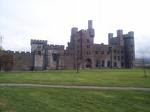
The Patron Saint of Wales is Saint David. Saint David's Day celebrates the life of the Patron Saint of Wales on March 1- The Welsh patriotic festival it celebrated since the 12 th century.
Saint David's parents were descended from welsh royelty. His father was prince of Powys. Saint David was educated at the monastery of Hen Fynyw, his teacher Paulinus was blind but according to legend, David cured his teacher's blindness, that is one of thousands miracles attributed to wales' patron. By the 9th century he had became known as Aquaticus or Dewi Ddyfrwr in Welsh. Saint David died on 1 march 589 A. D.
In the year 1120, Pope Callactus II canonised David as a Saint, and Patron Saint of Wales, the country where he had served as archbisshop.The town of sain Davids is the smallest city in the UK.
March 1 is marked with a tradicional feast and the wearing of a leek or daffodil wich are Wales' national symbols.



